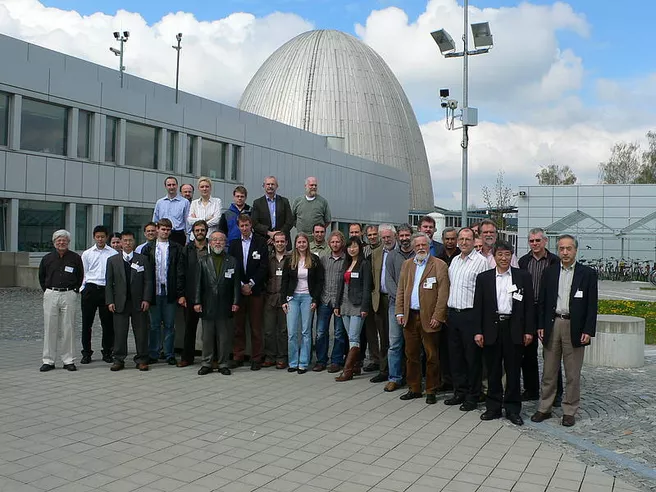For the first time, a meeting was held outside the "normal" sequence of conferences in neutron imaging for a dedicated topic gaining such high interest and participation. During 3 ½ days, about 40 leading experts from 9 countries all over the world exchanged their knowledge about two promising topics: Energy-dependent Imaging with cold neutrons and the progress in fast neutron imaging. A new format was successfully applied for the first time, with the number of talks very limited but with plenty of time for vivid discussion.
The research neutron source "Heinz Maier-Leibnitz (FRM II)" of Technische Universität München was chosen as conference site due to its expertise in both fields with its facilities ANTARES (cold neutron imaging) and NECTAR (fast neutron imaging). This activity was supported by the European network NMI3 (http://neutron.neutron-eu.net/n_nmi3).
During this meeting it became obvious that the new approach to do transmission imaging measurements with narrow energy bands of the applied neutron spectrum will enable a new field of material research and material characterization with cold neutrons. The number of facilities presently available for such kind of studies is very limited (about 5 worldwide). Consequently the presented results just give a first glance on future perspectives of the method.
It was demonstrated that the scattering behavior of most metallic materials for cold neutrons is characterized by the Bragg edges in the cross-section data due to diffractions at the lattices of the micro-crystallites. Depending on the neutron wavelength and the material properties, either the structural parameter of the material can be derived from transmission data, or local textures can be visualized in high spatial resolution. First impressive results of such imaging studies were presented.
These findings have direct impact on the decisions to go ahead to install also beam lines for neutron imaging at the upcoming new spallation neutron sources (ISIS-TS2, SNS, J-PARC, ESS-S). The pulse structure at these strong neutron sources is extremely promising for energy selective imaging, using the Time Of Flight (TOF) technique with high performance in respect to energy resolution and pulse intensity. The intense pulses can also be used for stroboscopic imaging of fast processes.
Currently, all four spallation sources are on different levels of consideration in respect to the installation of imaging facilities.
At ISIS-Target Station 2 (TS2), a project named IMAT is on the way for material research applications as extension and complement to activities at ENGINE-X. The goal is a setup which combines the imaging capability with a diffraction device for texture and stress analysis.
SNS is on a good way to reach the power of ISIS soon and will go beyond. Therefore, a real competition for the remaining beam ports at this source is expected. It will be necessary to apply for such a beam line option at the meeting of the Scientific Committee foreseen to be held in October 2008 with a Letter of Intent. A combination with a scattering device, e.g. a miniaturized SANS, was considered, which would strengthen the scientific impact of the proposal.
J-PARC will start operation during 2008 and commence user operation at the end of the year. The proposal system will start in Summer 2008. An elaborate universal test beam line is about to be completed for the start of user operation, which incorporates nearly all installations necessary for neutron imaging. Test measurements for imaging will be performed soon after commissioning in order to make a forecast for the future performance of a dedicated installation and to underline the layout design with realistic data.
ESS-S will have (if agreed) a strong intended link to industry, where neutron imaging will certainly play an important role. Although it is too early to make direct considerations in respect to design and layout of such an installation, ESS-S can take profit from the progress and the experience at the other sources mentioned above.
Beside these very important considerations about the future imaging capabilities at pulsed spallation sources, interesting new results in neutron imaging were presented. This was in particular about imaging with polarized neutrons for magnetic field and structure determination, phase contrast imaging, new set-up for fuel cell research and options for high resolution neutron imaging detectors. It became also clear that imaging and scattering methods will be more and more integrated and combined in future experiments.
The meeting was concluded with the explicit aim of the participants to continue the approaches and discussion in a follow-up event (NEUWAVE 2) to be held at one of the four sites of the pulsed spallation sources. The final decision about site, timing and content will be taken by latest at the ITMNR-6 meeting in Kobe (Japan), September 2008, (http://www.org.kobe-u.ac.jp/itmnr-6/).
